Since the first bountiful harvest came from the cucumber plants, they were the first vegetables that I canned. We searched for the 4- to 6-inch long young cucumbers and filled a small basket with them.
Before trying to do this, please take the time to read the Canning Resources links on the sidebar.
See the printer-friendly copy.
Ingredients:
For each quart, use 8-10 cucumbers, 4 garlic cloves and 2 teaspoons dill seeds.
For the brine, use 2 qt water: 1 qt cider vinegar (5% acidity) : 3/4 cup canning salt
Instructions:
Wash all jars and screw bandswith hot soapy water, or you can wash them in the dishwasher.
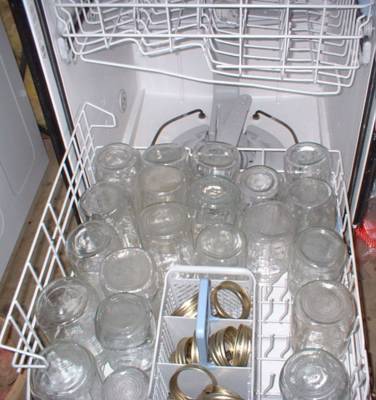
Prepare the boiling water canner by filling it up halfway with water without the rack and boiling it while you proceed with the other steps.
Pick 4- to 6-inch long cucumbers. Wash very well. Look for spots that show spoiling. If there are any, scrape or slice them off. Set aside.

Boil enough water to cover the jars and lids and screw bands. The clean jars should be filled with boiling water, to be emptied only when ready to fill with cucumbers.

Remove the hot water from the jars using a jar lifter, pack well with cucumbers (you may try to squeeze in the cucumbers upright) then add 4 cloves of garlic plus 2 tsp dill seeds to each quart (jars should be the wide-mouth type for easy packing of cucumbers so that your hand can reach into the inside).

To prepare brine, mix 2 qts water and 1 qt vinegar . Boil. Add 3/4 cup canning salt, mix to dissolve. (Increase the proportion according to the number of quarts that you have filled with cucumbers. ) Pour into the jars immediately.
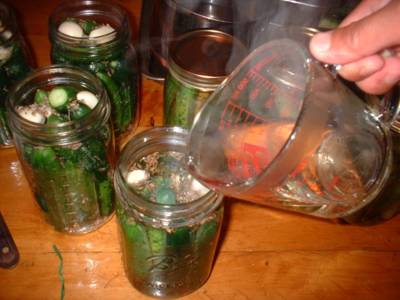
Using a non-metallic spatula or a bubbler, remove bubbles by gently poking into the inside of the jars. Wipe the rim with a clean damp cloth or a paper towel to remove seeds or anything that might interfere with sealing.
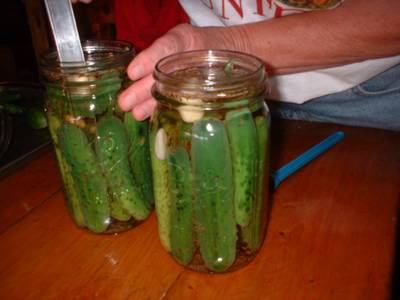
Lids and screw bands should be submerged in boiling water (not boiled, for it will damage the sealing compound, resulting to poor seal). Pick up with a clamp or magnetic picker whose tip/s were/was also submerged in the boiling water prior to using. To minimize contamination, refrain from touching the side of the lid that will touch the contents of the jar.
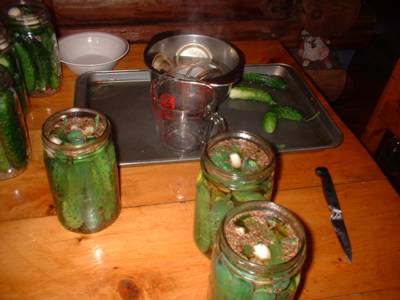
Close the jars fingertip tight then load onto the canning rack.

Lower them into the hot water. If water tends to overflow, remove some. Leave enough to cover the jars up to 1 inch above the lids. Turn heat to high and cautiously watch until the water gains enough heat to the point just before boiling (If it boils, lower the heat immediately) then start timing 15 minutes. Never allow to boil as this will COOK the pickles and will result to mushy, not crunchy, pickles.

Process for 15 minutes, never leaving it to ensure that the water does not boil. Otherwise, your pickles will be mushy instead of crunchy. (Yuck!)

While processing the cans, have a dry towel ready on the countertop near the stove. Close all windows and doors to avoid drafts (the sudden rush of cold air might crack the hot jars. Then after 15 minutes , one by one, carefully lift the jars (with a jar lifter especially designed for canning) out of the rack without banging them with one another (this might crack the jars as well). Place on top of the dry towel. Leave at least 1-inch space in-between the jars. Then when all the jars are out, cover with another towel. These towel will provide cushion for the hot jars not to crack when you place them on the countertop, and will also act as "windbreaker" in case there is a draft. You may now open your doors and windows. LEAVE THESE JARS ALONE FOR AT LEAST 3 HOURS before peeping under the towel, and preferably let them cool for at least 12 hours before moving them. You will hear the popping of the lids, which is a sign of good seal. If within 12 hours one or more of the jars did not seal, you may process them again or place in the fridge and consume them first within two weeks.

(Mom told me I should always be there with her during canning, as everything I made were sealed tightly. She would often come up with one or two improperly sealed jars. What a compliment from someone who has been canning for the past 40 years!)
Mom delivered to me my dill pickles the next morning (my son was excited to have his share in picture-taking!). These dill pickles will keep for one year, stored in a dark and cool place (not kitchen shelves nor the window sill!)
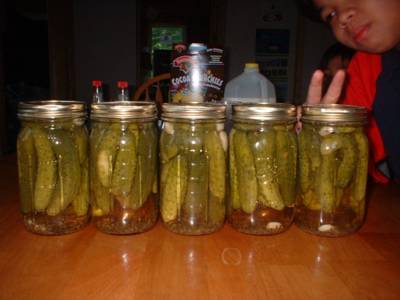
Hubby sometimes have these for snacks, or eats them with baked chicken. I have grown to like them because they reminded me so much of binurong mangga (which I learned from my previous mom-in-law using water and salt for indian mango), and has the same taste as the vinegar dressing (vinegar and salt and red and black pepper) which I used to make to dip my green mangoes into. Naglalaway tuloy ako maisip ko lang...

4 comments:
WOW! dill... my peborit pickles.
this is my kind of pickle especially the one that's not sweet. very difficult to buy in asia where almost all the ones available are sweetened.
*sigh* burong mangga...I can't bilib i had 3 babies here without green mangoes for the lihi. If you say the dill pickles remind you of them, then...pahingi??hihi.
Batjay, ayan gawa ka na lang ng sarili mong dill pickles. Walang sugar yan. para ka lang nagsawsaw ng hilaw na mangga sa suka't asin. (drool...)
drstel, kung pwede lang ba makuha mo from the monitor yung pickles no?
hello, your blog is very interesting, i have visited last year, i have been reserching about food preservation in 2003. i am thinking if this is the blog i have seen that time when i was looking for food canning!
Post a Comment